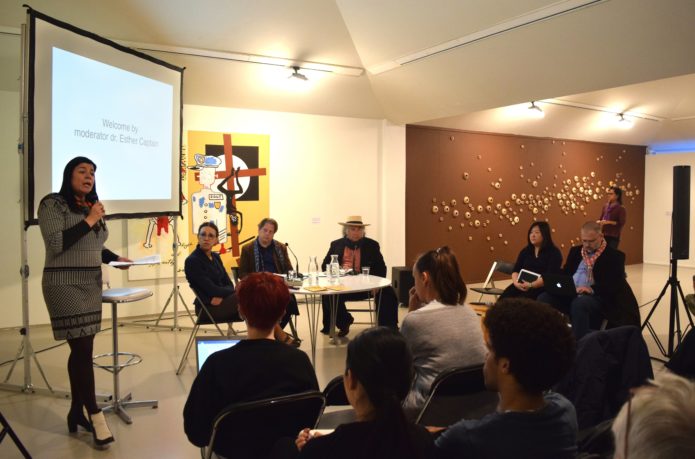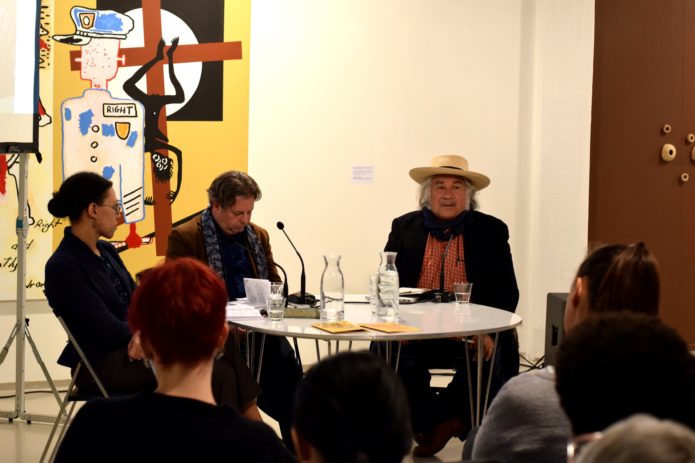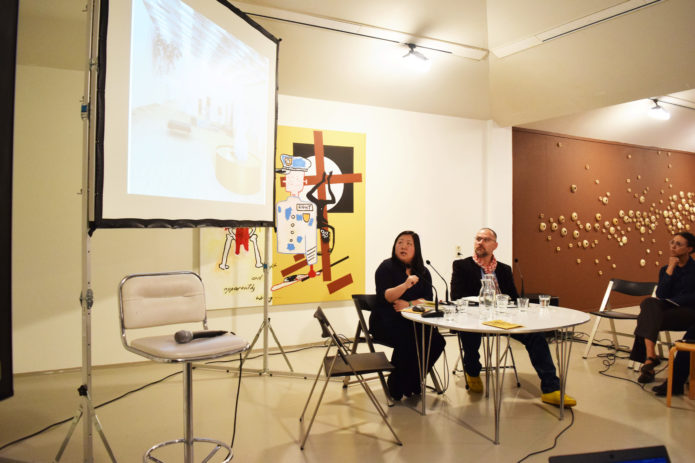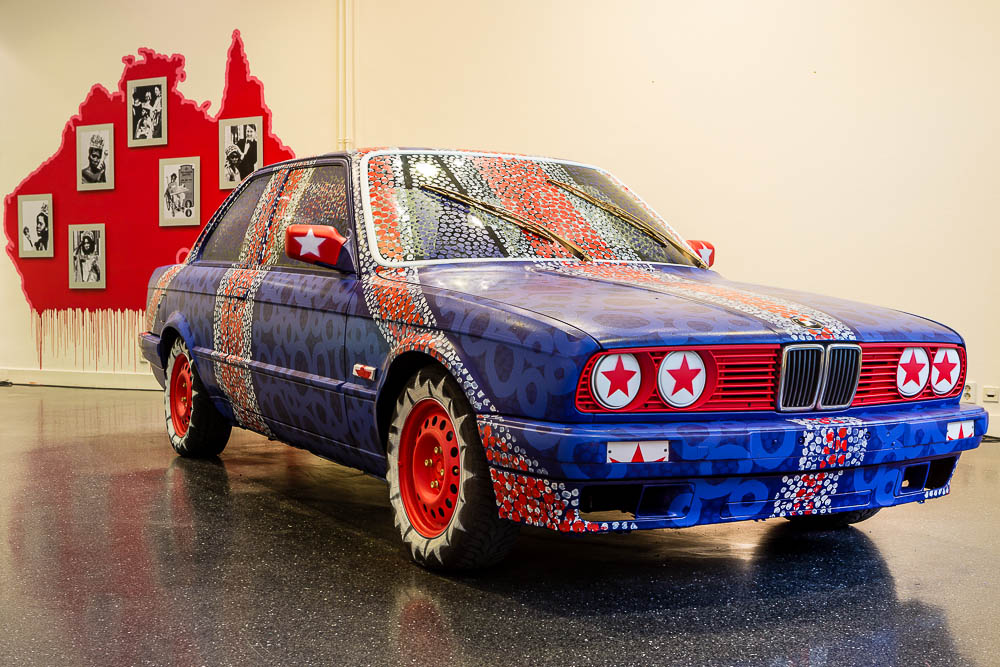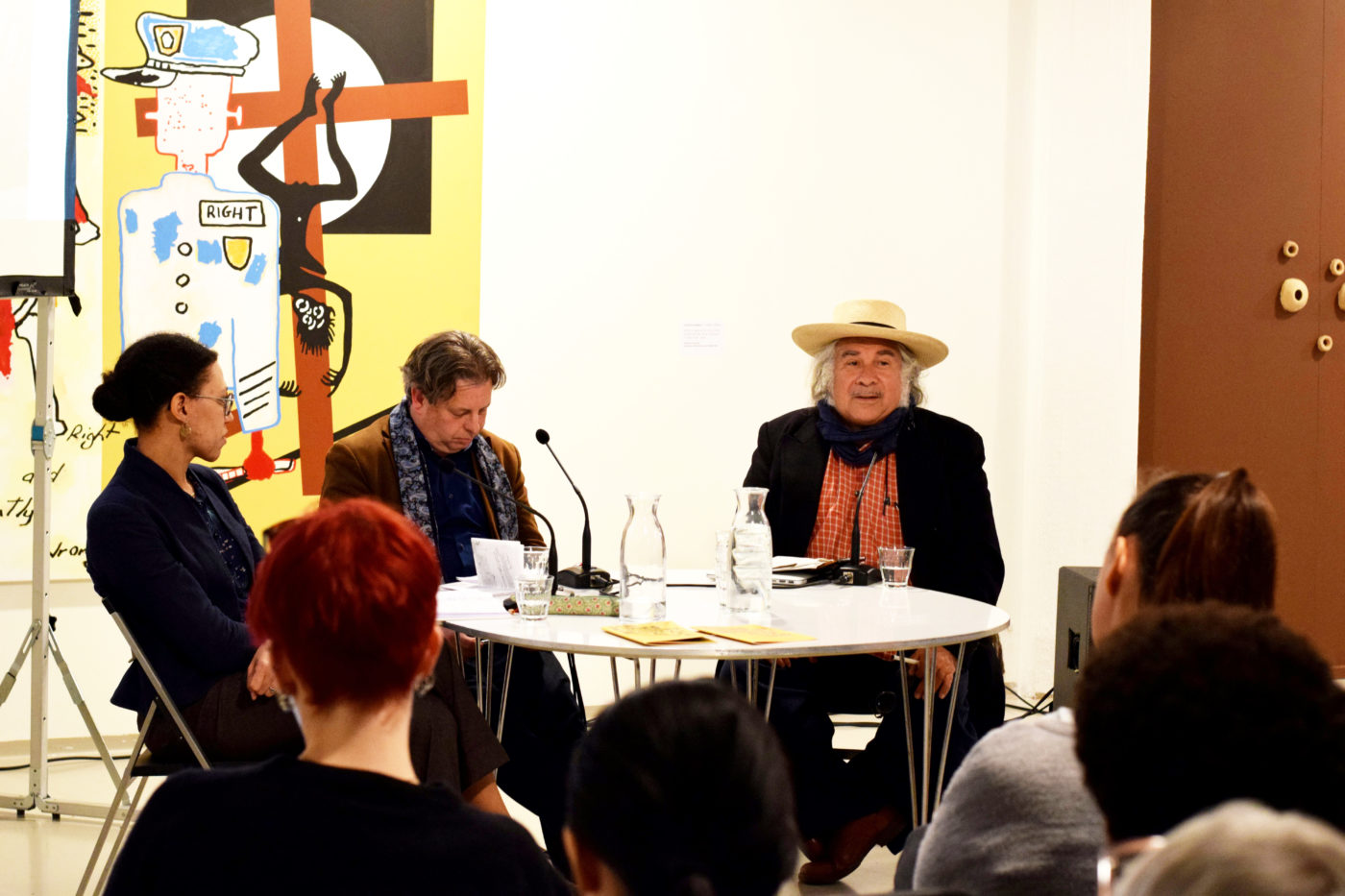 Panel discussion In the future everything remains uncertain: A discussion on art collections in flux (22 april 2017) with speakers Wonu Veys, Georges Petitjean, and Djon Mundine.
Panel discussion In the future everything remains uncertain: A discussion on art collections in flux (22 april 2017) with speakers Wonu Veys, Georges Petitjean, and Djon Mundine. Report: On the future of the AAMU collection and the outlook of contemporary Aboriginal art
On Saturday the 22 of April 2017 Framer Framed hosted a symposium named In the future everything remains uncertain: A discussion on art collections in flux. This symposium was organized in connection with the exhibition In the future everything will be as certain as it used to be (open from 16 March to 23 April 2017), which was a collaboration between Framer Framed and the AAMU – the Museum of contemporary Aboriginal art in Utrecht, NL. (Scroll to the bottom for a video registration of the symposium.)
The event sought to mark the end of the exhibition at Framer Framed; an exhibition which, in and of itself, chronicled the closure of the AAMU (on 15 June 2017) by displaying some of the most significant artworks of its collection, curated by Georges Petitjean (curator of the AAMU since 2005). Tying into this, the symposium was formulated to discuss the current state of museum policies in the Netherlands and beyond; looking to exchange views on the present position of contemporary Aboriginal art in different institutions.
It is here important to point out that discussing contemporary Aboriginal art in the context of the art institution often entails reviewing and scrutinizing confining notions of how these art collections are classified. Why, for instance, is Aboriginal art frequently labelled as ethnographical; particularly considering how the ethnographical object is repeatedly treated as belonging in a traditional framework, and not in a present-day one? In relation to this, why is contemporary Aboriginal art exhibited in ethnographical museums, and not in contemporary art institutions such as the Stedelijk? In this context, the AAMU is notable, as it has aimed to present its exhibitions as a contemporary art museum (not an ethnographical one); often being critical of such classifications. Therefore, the decision of moving the AAMU collection to the National Museum of World Cultures (NL) after its closure is noteworthy, especially because the receiving institution comes from an ethnographical background: it is a composite of the Museum Volkenkunde, the Tropenmuseum, and the Afrika Museum. These, as well as other questions and ideas related to the overall theme of the symposium, were discussions raised throughout In the future everything remains uncertain.
The symposium consisted of five presentations given by five panel members, who would take turns in presenting and debating their work, and a moderator who chaired the event: Esther Captain, the Head of the Centre for Applied Research on Education of the Amsterdam University of Applied Sciences (HvA). As for the organization of the symposium, it was structured as follows: firstly, the previously mentioned Georges Petitjean introduced the history, collection, and perspectives of the AAMU in detail; and followingly, Wonu Veys (Curator Oceania at the National Museum of World Cultures) presented the museum’s plans for the future of the AAMU collection. These two talks focused on the current state of contemporary Aboriginal art in Dutch institutions; and once they ended, the focal point of the discussion moved towards an international outlook. To do so, Djon Mundine OAM (independent curator, artist, activist and writer; a member of the Bandjalung people, born in Grafton NSW, and currently a PhD student at the University of NSW Art & Design School) shared his thoughts on the topics discussed. Sook-Kyung Lee (Senior Research Curator at Tate Research Centre) was the following to speak, as she talked about the Tate International Joint Acquisition Programme for contemporary Australian art (of which she is one of the initiators) – a project that collaborates with the Museum of Contemporary Art Australia (MCA) to include Australian (and Aboriginal) artists in the Tate’s collection. The last speaker to present before the closure of the event was Thomas Berghuis (curator and art historian, currently a Visiting Fellow at Tate Research Centre: Asia); who shared a more critical perspective on the topics discussed throughout the symposium.
In her introduction of the event, moderator Esther Captain underlined the collaboration between Framer Framed and the AAMU (which has been going on since 2009), and stressed the unfortunate closure of the latter. After briefly presenting the different speakers of the afternoon, she gave the floor to Georges Petitjean. The curator started his talk by emphasizing the cooperation between both institutions; tracing it back to the very first public meeting of Framer Framed in the AAMU in 2009 – coinciding with Brooke Andrew’s exhibition Theme Park –, and remembering the 2010 Australian magazine Artlink launch of the Blak on Blak issue (also in the AAMU, in 2010), as well as Artlink’s Indigenous Art Now issue launched in London in 2011. Petitjean continued his presentation by explaining that the AAMU was founded in 2001 as a private initiative, undertaken by private collectors who donated around five-hundred art pieces. Additionally, three institutions gave part of their collection to the museum: the University Museum of Groningen (NL), who themselves had received a selection donated by the Australian government in the 1970s; the Groningen Museum (NL), who decided to donate their Aboriginal art collection after a change in director; and the World Museum of Rotterdam (NL), who regarded some of their pieces as too contemporary (as they were interested in art made before 1945). As a result, the AAMU collection is currently composed by five-hundred private artworks, plus three collections permanently on loan.
Throughout his presentation, the curator stressed how the AAMU grew into much more than a museum: it became a meeting place, as well as a space for diplomatic exchanges. As an example of how the museum became a diplomatic platform, he mentioned the Law Poles that were donated by Aboriginal communities to the Dutch people in 2007, commemorating the first contact between Indigenous Australians and Europeans in 1606. This was an important symbolic act, as when Australia was colonized it was regarded as an uncivilized land – a land without law. Hence the significance of donating these Law Poles to the Netherlands: with this, Aboriginal laws symbolically travelled to Europe, exerting their own word on the subject. Georges Petitjean ended his presentation by reviewing some of the most notable exhibitions the AAMU has hosted, including Theme Park (2008) – created by artist Brooke Andrew –, which aimed to reverse classic institutional roles and convert the museum into the exhibition’s “working material” (quoting Petitjean’s words), transforming the AAMU into a truly existing theme park[1].
Dr. Wonu Veys was the second speaker to present in the symposium. Veys, who is the Curator Oceania at the National Museum of World Cultures, discussed both the existing policies of the museum and their upcoming plans for the AAMU collection. Upon illustrating their current policy, the speaker explained how it developed as a result of the 2014 merge of the three museums that form the National Museum of World Cultures (Museum Volkenkunde, Tropenmuseum, and Afrika Museum). With this merge, the National Museum of World Cultures became one of the only classical ethnographical museums in the Netherlands. In relation to their policy, when acquiring new collections one of the most relevant questions the institution focuses on is the following: how can these objects tell “stories of dynamics and changing cultures” (quoting the speaker)? To delve into this, Veys explained how the museum centres on certain areas or disciplines with the aim of becoming specialized in them; these are popular culture, fashion, design, contemporary art, and photography.
The AAMU collection will relate to the National Museum of World Cultures’ policy in that it will allow for the exploration and presentation of different multi-vocal perspectives. Veys outlined the importance of this, given the pre-conceived notions of what contemporary Aboriginal art is for the Dutch audience. Clichéd ideas can be contested by exhibiting pieces such as the aforementioned Law Poles, for instance, as they constitute a different perspective on Aboriginal cultures by shifting the attention to their point of view. When discussing the future of the collection the speaker explained that they want to bring visibility to the artworks; by making them accessible online, exhibiting them on different displays (both regionally and thematically), and mobilizing the collection through loans. Wonu Veys closed her presentation by stressing the importance of research in connection to the artworks, as this will maintain and generate both cultural and diplomatic relations adamant to the museum’s collection.
Once the setting of Aboriginal art collections in the Netherlands had been discussed, the symposium took an international turn with the presentation of Djon Mundine. After briefly introducing himself and thanking those present, the artist outlined his work as an independent curator, having worked for institutions such as the above mentioned Troppenmuseum (NL), the Hayward Gallery (UK), the Hermitage Museum (RU), and others. Mundine began his talk by clarifying that until 1958 Aboriginal peoples were not present in Australian art galleries (and if they were, they were unnamed). As for museums, their collections generally referred to ancient cultures and societies that had vanished, promoting the notion that only Western societies were worthy of being considered “clever” (in his own words) – whilst other cultures were simply strange and exotic. Nevertheless, this started to slowly change in 1959, when the Art Gallery of New South Wales started collecting Aboriginal objects and pieces as art. Other institutions did not believe these belonged in a gallery. As the speaker explained, this was the first of many discussions on the status of modern and contemporary Aboriginal art in Australia: what could be considered art, and what couldn’t? In Mundine’s words, the eventual acceptance of Aboriginal artworks as art was a breakthrough that “moved Australia forward to think about other things”, ultimately opening the artistic canons of the country.
Reflecting on the topic of the symposium, the speaker stressed that his main question in relation to the subjects discussed was the following: since we (cultural workers, artists) all strive to define ourselves through our cultural practice, how can Aboriginal peoples define and self-identify themselves? Is the act of bringing Aboriginal peoples into dialogue with the diplomatic platform of the museum institution another version of “the white man’s burden” (particularly if we think of a place such as Australia, where every art gallery has an Aboriginal curator)? Djon Mundine then presented Aboriginal Memorial (1988), a work he devised, which is currently installed in the National Gallery of Australia commemorating the Indigenous peoples that were killed since the occupation of the country by the British in 1788[2]. The work, which was first created for the Sydney Biennale of 1988, consists of 200 burial poles – coinciding with the 200 years of occupation of Aboriginal land – arranged next to a pathway. After delving into the story of the piece, the artist closed his talk by visiting several other artworks created by Aboriginal artists, updating the audience on his current projects, and expressing his thoughts on the predictability of the future.
Before continuing the symposium’s talks by inviting the next speaker to present, the moderator announced a brief hiatus to address the audience’s questions. In this break, Georges Petitjean was asked how he felt about the AAMU collection ending in an ethnographical museum – given that many of the participating artists refuse the ethnographic gaze. To this, the curator answered that he would have preferred to see the collection go to the Stedelijk Museum of Amsterdam (an institution for modern and contemporary art), but this was unfortunately not possible. Followingly, Djon Mundine addressed the topic of the value of art, mentioning that Aboriginal peoples still do not control their own image nor get to discuss their art themselves. After shortly delving into other topics the moderator communicated the end of the break. With this, the next speaker – Dr. Sook-Kyung Lee – was introduced.
Under the PowerPoint banner Postcolonial perspectives on collection policies, Lee introduced her talk by presenting the Tate International Joint Acquisition Programme (2015-2020), created in collaboration with the Museum of Contemporary Art Australia (MCA), and funded by the airline company Qantas. The programme, which is partly housed by the 2016 spatial expansion of the Tate Modern (UK), wants to “increase the international profile of contemporary Australian art”[3] by purchasing Australian artworks to exhibit in both the Tate and the MCA. It responds to the museum’s aim to embrace a “more globalised vision of contemporary art” (present since the museum’s opening in 2000), in the speaker’s words. Interestingly, Tate do not use concepts such as “postcolonial” or “decolonial” as keywords, but focus more on notions like “translational”, “translocal”, “global”, and others. In relation to this, Lee spoke about exploring “what is actually happening in contemporary art scenes” of places other than the usual (looking beyond Paris, London, New York, etc.); as a way of ultimately engaging not only with the global present, but also of revisiting different art histories that have developed outside of the US and Europe.
Upon introducing the ambitious model of display of the Tate Modern collection, Sook-Kyung Lee explained how their approach (particularly present in their new building) involves exhibiting works thematically; placing pieces from different parts of the world, and from diverse times, in one same room. The speaker gave a few examples of this, focusing on the institution’s willingness to acquire artworks that do not belong to a Western context, or are not made by men. After delving into the Tate’s special pursuit of performance art, Lee pointed out their need to display the works acquired: the museum only buys the works that they want to display – which is a crucial aspect of the Joint Acquisition Programme (as the pieces aren’t collected, but exhibited). The speaker ended her talk by sharing some of the artworks they have already purchased through this programme; such as Gordon Bennett’s Possession Island (abstraction) (1991) and Number Nine (2008), and Vernon Ah Kee’s tall man (2010). These have been acquired by Tate and MCA together (with the funding of Qantas), and will be exhibited in both museums[4].
Once Sook-Kyung Lee’s presentation ended, the fifth and last speaker of the symposium – Dr. Thomas Berghuis – took over. Berghuis started his talk by reflecting on how diverse art institutions have become. He then pointed out some of the challenges of Dutch cultural institutions, implying that they are not politicized enough; and was critical about institutions using certain words simply because they have become trendy (as is sometimes the case with the concepts such as postcolonialism and decolonialism). The speaker was also critical of the departmentalization of museums, as it isolates them from a type of curatorial practice that allows for true dialogue between artists and/or curators. Berghuis recalled Aboriginal artist Gordon Hookey’s words at the AAMU and Framer Framed public meeting of 2009 – “if you take our art, you have to take the reality of our politics” – to express this disconnection. He urged museums to be conscious of the reality of Aboriginal people, and stressed that curatorial practices should focus precisely on these everyday realities.
Upon discussing how cultural institutions have not only become places for entertainment, but also for consumption, the speaker called for – in his words – an awareness of the “contemporary realities of capital” (not only of concepts such as colonial and postcolonial). With this, he suggested a more in-depth analysis of how capital intersects with culture. This would mean to move beyond interpretations of Aboriginal art that solely focus on identity traits; advocating for the reality of Aboriginal politics to become intertwined with both curatorial and institutional practices. Berghuis ended his presentation by reflecting on the Dutch context, and expressing the need to keep debates on the nature of the cultural institution alive; leaving aside what he named a “self-imposed pride” that has eclipsed many of these debates.
Immediately after, Josien Pieterse (director of Framer Framed) shortly reflected on Thomas Berghuis’ critical considerations. The panel members then briefly answered a few questions from the public; again, addressing the future of the AAMU collection, as well as discussing the principles and outlooks of the National Museum of World Cultures – which, as mentioned previously, has had a long trajectory as an ethnographic museum. In relation to this, panel member Wonu Veys spoke about the museum’s approach to the AAMU collection, and its willingness to demarcate itself from classic ethnographic attitudes, meaning that art is an integral part of exploring ways of being the world. Followingly, Sook-Kyung Lee answered some questions on the Tate International Joint Acquisition Programme, and reflected on the closure of the AAMU. Shortly after, Esther Captain closed the question round, marking the end of an engaging and thought-provoking symposium.
In the future everything remains uncertain was an event that, in seeking to outline the nature of art collections in flux, it stressed the unclear future of Aboriginal art in a wider art history canon. One could say that the unfortunate closure of the AAMU can add to this uncertainty, as the museum’s collection will be allocated to an institution with a different approach to that of the Museum of contemporary Aboriginal art. Nevertheless, it is important to point out that change often brings development; and as such, it will be undoubtedly interesting to see how the collection evolves under the views and purposes of the National Museum of World Cultures.
Report written by Iona Sharp Casas,
video registrations of the symposium can be found below.
[1] For further information on this exhibition, I recommend reading Marianne Riphagen’s article Theme Park: A Rollercoaster Ride, published in Art Monthly (July 2009).
[2] Reference: The Aboriginal Memorial, National Gallery of Australia website.
[3] Reference: Quantas: International Joint Acquisition Programme for Contemporary Australian Art, Tate Corporate sponsorship website.
[4] Reference: MCA, Quantas, and Tate Collaboration, MCA website.
Video registration of the symposium by De Documentairefabriek:
Contemporary Aboriginal art / Collection development / Museology /
Exhibitions
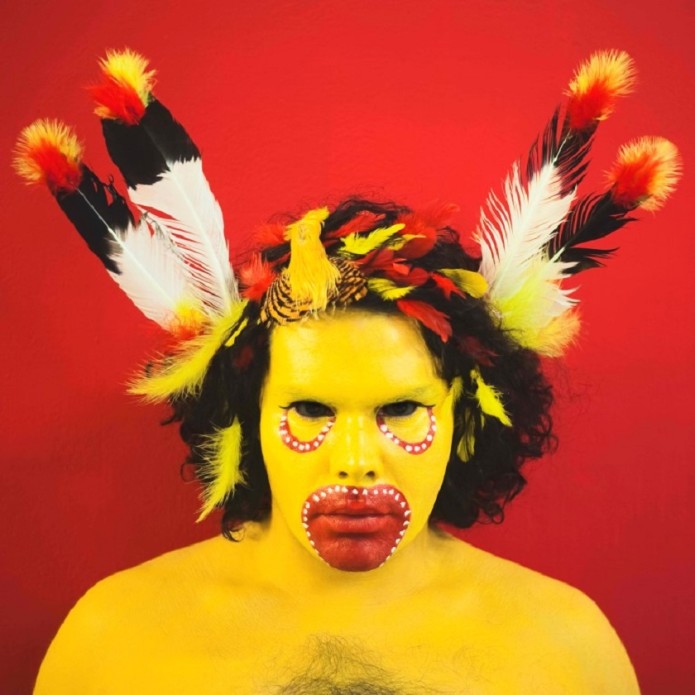
Exhibition: In the future everything will be as certain as it used to be
Exhibition in collaboration with AAMU - Museum of contemporary Aboriginal art, in light of their closure
Agenda
Symposium: In the future everything remains uncertain
A discussion on art collection policy in the Netherlands.
Network
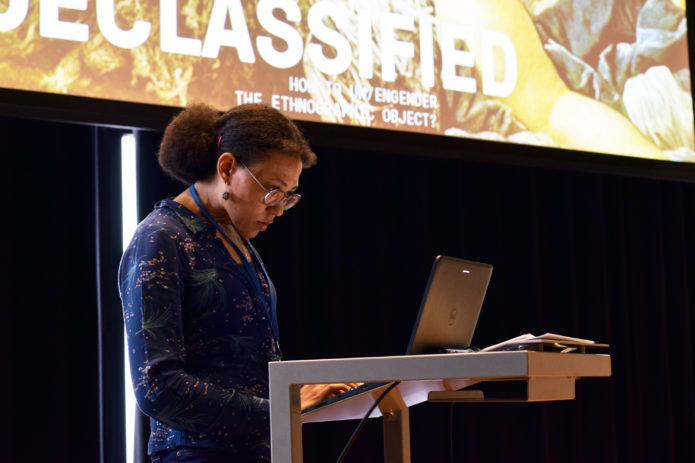
Fanny Wonu Veys
Curator Oceania
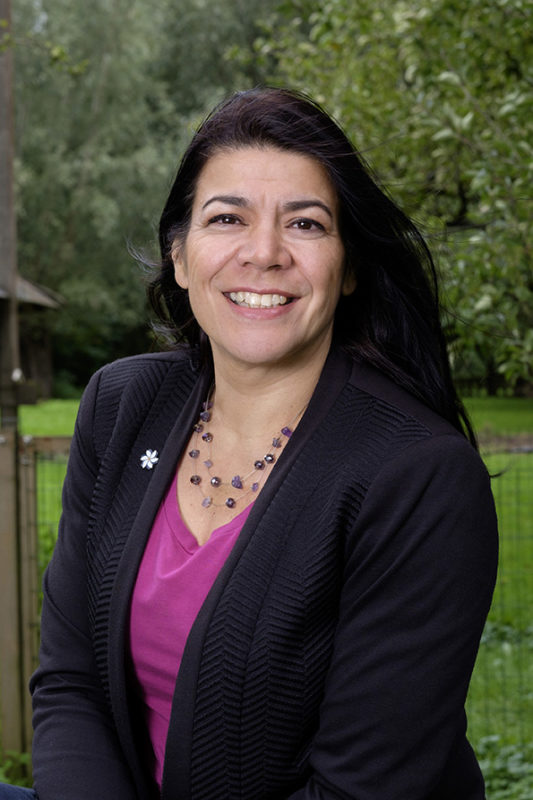
Esther Captain
Historian

Thomas Berghuis
Curator, Author

